Spicy Green Tomato Salsa Verde Canning Recipe
This post may contain affiliate links, which means that I may receive a commission if you make a purchase using these links. As an Amazon Associate I earn from qualifying purchases.
Discover a delicious solution for your abundance of unripe green tomatoes with our home-canned green tomato salsa verde recipe.
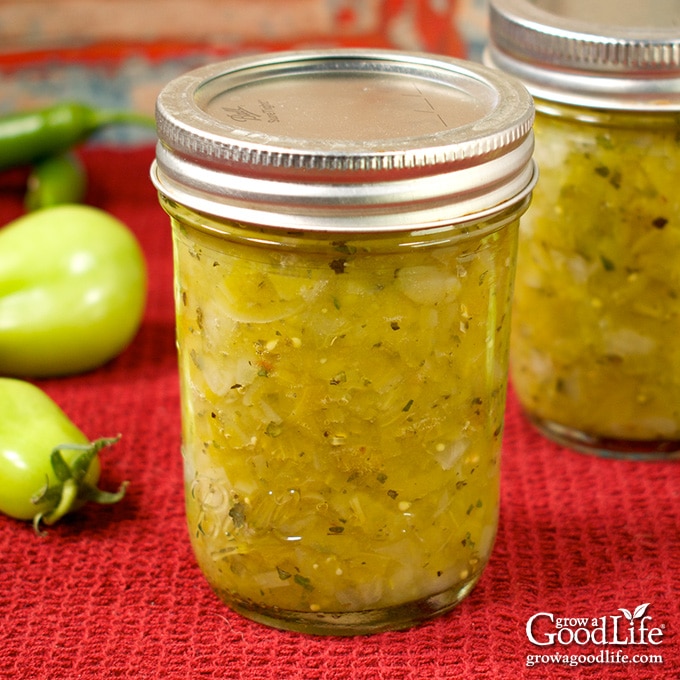
Are you faced with an abundance of unripe green tomatoes in your garden? Whether you have pruned or thinned your tomato plants to promote healthier growth, or it’s the end of the growing season, and you’re left with a batch of under-ripe fruits, don’t worry!
Home canning green tomato salsa provides the perfect solution for making the most of your harvest. Instead of letting those green tomatoes go to waste, transform them into a delicious and tangy salsa that can be enjoyed throughout the year.
By preserving the vibrant flavors of these unripe tomatoes, you’ll create a versatile condiment that adds a zesty kick to your meals and allows you to savor the taste of your garden well beyond the growing season.
Throughout this post, we’ll walk you through each step of the process, from selecting the freshest ingredients to making and canning your salsa. We’ll also provide helpful tips and tricks to ensure your salsa turns out perfect every time.
So, gather your ingredients and canning equipment, roll up your sleeves, and let’s dive into this green tomato salsa recipe. Get ready to savor the flavors of homemade goodness that will brighten up your meals all year long!
About the Ingredients
Before diving into the process of making and canning your own green tomato salsa, it’s important to understand the key ingredients and their roles in creating a delicious and safe canned salsa.
While maintaining the total amount of ingredients is crucial for canning safety, there is flexibility in the varieties of some ingredients, such as the varieties of peppers and onions that you can use.
Additionally, the dried spices used in the recipe provide an opportunity for customization and personalization. Let’s explore the essential ingredients and how they contribute to the salsa’s overall flavor.
Unripe Green Tomatoes
Selecting the right green tomatoes will help you achieve the best flavor and texture when making green tomato salsa. Here are some tips for choosing green tomatoes::
- Color: Unripe green tomatoes typically have a vibrant, pale green color. Avoid tomatoes that are turning yellow or showing signs of ripening. While these can still be used safely in this recipe, they may be too soft and sweet for the desired tangy flavor of green tomato salsa.
- Firmness: Look for unripe green tomatoes that are firm to the touch. They should feel solid and not yield much when pressed. Avoid tomatoes that show signs of rot, mold, or insect damage.
- Size: Choose large to medium-sized green tomatoes, as these tend to have a better balance of flavor and texture. Since this recipe calls for peeling the tomatoes, it’s also worth noting that larger fruit are easier to peel than smaller ones.
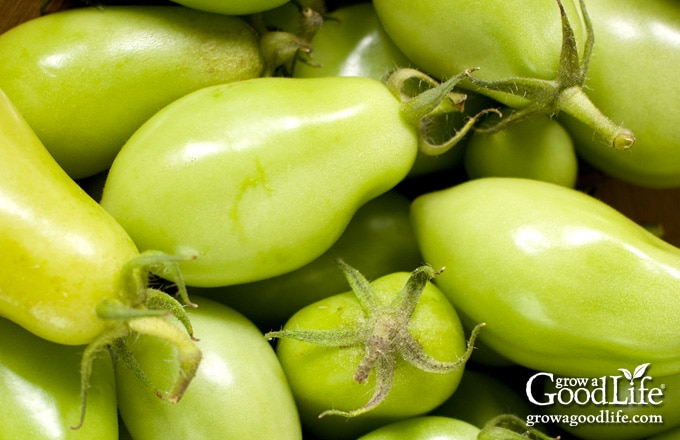
Peppers
While the recipe calls for jalapeños, feel free to experiment with different varieties to suit your taste preferences. For example, if you prefer milder salsa, you can opt for bell peppers or other mild varieties. On the other hand, if you crave more heat, choose hotter peppers like Serrano or Habanero chiles.
Each type of pepper brings its own flavor profile and heat level to the salsa. So feel free to experiment with different pepper varieties and even combine them to create your own unique flavor profile and preferred level of spiciness. Here are a few popular options:
- Jalapeño Peppers are commonly used in salsa and provide medium heat. They have a slightly sweet and grassy flavor, making them a versatile choice for salsa recipes. Use fewer peppers, and remove the seeds and membranes for a milder taste.
- Serrano Peppers are similar in heat to jalapeños but are generally hotter. They offer a bright, crisp flavor with a more pronounced heat, adding a fiery kick to your salsa. Use them sparingly if you prefer a milder salsa.
- Anaheim Peppers are mild to medium in heat and have a slightly sweet flavor. Roasting or grilling them enhances their flavor further, providing a pleasant, smoky flavor to your green tomato salsa.
- Habanero Peppers are known for their intense heat, so they should be used with caution. They have a fruity and citrusy flavor that pairs well with green tomatoes. Incorporate habaneros for a fiery twist to your salsa, but be mindful of their spiciness level.
- Poblano Peppers have a mild to medium heat level and offer a rich, earthy flavor. They are often roasted and peeled before being added to salsa, enhancing their smokiness and depth of flavor. Poblanos are an excellent choice for milder salsa with a complex taste.
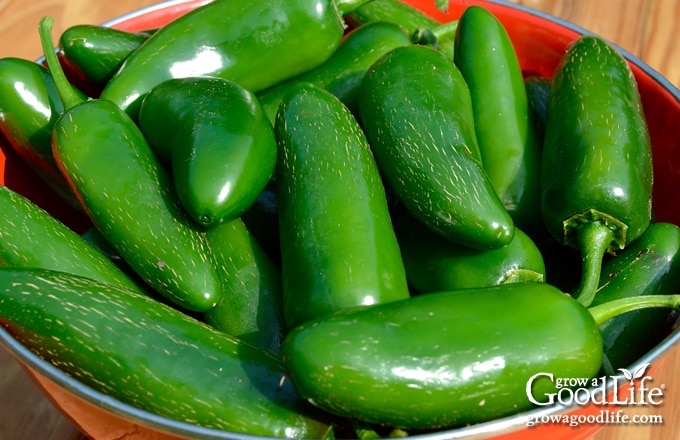
Onions
The type of onion you choose can greatly impact the taste of your green tomato salsa. Feel free to experiment with different onion varieties to find your preferred flavor combination. Consider the following options and their characteristics:
- Yellow Onions have a robust flavor and are slightly sweet when cooked, making them a versatile choice for salsa recipes.
- White Onions have a milder and slightly sweeter flavor than yellow onions.
- Red Onions offer a mild to moderate pungency, adding a pleasant onion flavor to salsas.
- Spanish Onions are known for their large size and mild flavor. They have a slightly sweet taste and are ideal for those who prefer a subtler onion presence in their salsa.
Dried Spices
Dried spices play a significant role in enhancing the flavor of your green tomato salsa. While this recipe specifies ground cumin, dried oregano, salt, and black pepper, you can adjust the dried spices to suit your personal preferences.
When canning, it is generally safe to reduce or swap out dried spices without compromising the safety of the recipe. For example, I am not a fan of cumin, so I usually leave it out when making this recipe. I also reduce the amount of salt. You can even add a little sugar to balance the tart flavor if desired.
While this recipe specifies ground cumin and dried oregano, you can replace them with equal amounts of other dried spices. Let’s explore some popular options:
- Chili Powder: Adding chili powder can infuse your salsa with a mildly spicy flavor, providing a subtle kick without overpowering the other ingredients. It often includes a blend of chili peppers, cumin, garlic powder, and other spices, offering depth and complexity to the salsa’s overall taste.
- Smoked Paprika: If you’re seeking a smoky twist, consider using smoked paprika. This dried spice adds a rich, smoky flavor reminiscent of barbecue or charred peppers. It lends a distinct aroma and a touch of mild heat to your green tomato salsa.
- Ground Coriander: Ground coriander is a fantastic alternative that imparts a citrusy and slightly floral note to your salsa. Its delicate flavor complements the other ingredients, adding a subtle brightness and complexity to the overall taste profile.
- Chipotle Pepper: Ground chipotle pepper can be a fantastic substitution for those who enjoy a smoky and robust flavor. Chipotle peppers are smoke-dried jalapeño peppers, offering a unique combination of heat and smokiness. Incorporating ground chipotle pepper into your salsa can provide a slightly spicy, smoky element.
So feel free to explore various pepper varieties, onion types, and even dried spices to craft a salsa that suits your unique taste preferences. Just ensure the overall quantities remain consistent for a safe and flavorful green tomato salsa.
Steps for Making and Canning Salsa Verde
If you’re looking for a way to transform those unripe, tangy green tomatoes into a jar of zesty goodness you can enjoy all year round, you’ve come to the right place. In this recipe, we’ll guide you through the process of creating your own homemade green tomato salsa and preserving it through the canning method.
If you are canning your own salsa, it’s essential to follow recipes that have been carefully formulated and tested to ensure the right proportion of acidic ingredients for safe home canning. The acidity level is crucial because it helps prevent the growth of bacteria, like botulism, and ensures your preserved salsa stays fresh and delicious.
This is the “Salsa Verde” recipe from the Ball Complete Book of Home Canning and the Ball Blue Book Guide to Preserving. You can find a more detailed and printable recipe at the bottom of this article, but these are the general steps for making and canning salsa:
Step 1: Gather Your Kitchen Equipment
To ensure a smooth salsa canning process, gather the following kitchen supplies:
- Knife and cutting board: Select a sharp knife and a sturdy cutting board for preparing the ingredients.
- Measuring cups: Keep large measuring cups nearby to measure ingredients during the salsa-making process precisely.
- Gloves for handling hot peppers: It’s wise to wear gloves when handling hot peppers, such as jalapeños, to protect your hands from potential irritation and prevent transferring heat to sensitive areas, like your eyes.
- Water bath canner with canning rack: A water bath canner is essential for safely preserving your salsa. Ensure you have a canner with a fitted canning rack to hold and elevate the jars during processing.
- Canning jars: This recipe uses 6 half-pint (8-ounce) canning jars or 3 pint-sized (16-ounce) canning jars.
- Lids and bands: Use new canning lids for each jar to ensure a proper seal. The bands can be reused as long as they are in good condition.
- Canning tools: Have essential canning tools on hand, including a jar lifter for safely removing hot jars from the canner, a canning ladle for transferring salsa into the jars, a funnel to prevent spills, and a bubble popper to remove air bubbles from the filled jars.
- Basic kitchen supplies: Additionally, have large prep bowls for holding ingredients, a large saucepot for cooking the salsa, a slotted spoon, and plenty of clean kitchen towels.
Step 2: Prepare the Canning Equipment
Properly preparing your canning equipment is essential for a successful canning session. You may find this tutorial from the National Center for Home Food Preservation website helpful: Using Boiling Water Bath Canners.
Start by washing your jars, lids, bands, and canning tools in warm, soapy water. Rinse them well and set aside the lids, bands, and tools to air dry until you are ready to use them.
Heat the jars before filling them to prevent breakage due to thermal shock. Place the jar rack inside the water bath canner. Arrange the jars upright in the canner and add enough water to cover them. Bring the canner to a simmer at 180°F (82°C) and let the jars warm for 10 minutes. Keep the jars hot until you’re ready to fill them. Follow the manufacturer’s directions for preparing the lids.
Step 3: Prepare the Ingredients
The ratio of ingredients is important to maintain the proper balance of acid in this canning recipe. To achieve this, prepare the tomatoes, peppers, and onions one ingredient at a time, and then measure the chopped ingredients with a measuring cup before adding them to your large saucepan. This will ensure you have the correct proportions.
Green Tomatoes
First, wash the tomatoes well under running water. Then, you will need to blanch and peel green tomatoes the same way you would red, except they will need more blanching time before the skins separate. I found cutting the tomatoes in half before blanching helped. Once the skins begin to lift and curl along the edge of the cut side, they are much easier to slip off.
To blanch, bring a large pot of water to a boil over high heat, and fill a large prep bowl with ice water. While working in batches, cut the green tomatoes in half, remove the core, and drop them into the boiling water until the skins loosen, about a minute or so. Next, remove the tomatoes from the pot and plunge them into the ice water.
After you have finished blanching the tomatoes, empty the pot, rinse it out and set it nearby. This is the pot you will use to simmer your salsa.
Once the tomatoes are cool enough to handle, slip off the skins and chop them into 1/4-inch pieces. Use the measuring cup to measure 7 cups of chopped, cored, peeled green tomatoes, and add them to a large sauce pot.
Peppers
Wash your jalapeños under running water. Wear gloves when handling hot peppers and avoid contact with your skin and eyes. Remove the stems, and cut the peppers in half. You can scrape out the seeds and membranes with a spoon for less heat. Chop the peppers into 1/4-inch pieces and add them to the pot.
If you are substituting other types of peppers, 5 to 10 medium-sized jalapeños, when seeded and chopped fine, equals about 1/2 cup to 1 1/2 cups.
You may want to peel the skin if using long chile-type peppers such as Anaheim, Colorado, or New Mexican chiles. The tough skin can give an unpleasant texture to salsa. Thin-skinned peppers, such as bell peppers, banana, and jalapeños, don’t need to be peeled.
Onions
Use a sharp knife to cut the ends off the onions and slice them in half. Peel off the papery skins and discard. Cut the onions into 1/4-inch pieces. Measure the chopped onions and add 2 cups to the pot.
Garlic
Peel and finely chop the garlic, then add it to the pot.
Cilantro
Wash the cilantro well under clean running water. Remove the leaves from the stems and chop fine. Measure 1/2 cup loosely packed finely chopped cilantro leaves and add them to the pot.
Step 4: Simmer the Salsa
Add the lime juice to the pot and bring it to a boil over medium-high heat, stirring constantly. Once it reaches a boil, reduce the heat to medium and add the cilantro, cumin, oregano, salt, and pepper. Stir well to combine all the ingredients.
Let the salsa gently boil for 3 minutes, stirring frequently to prevent sticking. Then turn off the heat and fill your jars.

Step 5: Can Your Tomato Salsa Verde
Prepare your workspace by spreading a kitchen towel on the counter. Then, using the jar lifter, carefully remove a hot jar from the canner, allowing the water to drain back into the canner. Place the jar on the towel and keep the remaining jars in the canner to maintain their warmth.
Position the canning funnel on top of the jar and use the ladle to fill the jar with hot salsa, leaving a 1/2-inch headspace at the top. This space allows for proper sealing and expansion during processing. Run the bubble popper through the salsa-filled jar to release any trapped air bubbles. Adjust the headspace if necessary by adding more salsa or removing some.
Take a damp towel and wipe the rim of the jar, ensuring it is free from any residue or food particles. This step helps create a clean seal. Next, center a lid on the jar’s rim, then place the band over the lid. Secure the band by screwing it on until it is fingertip tight.
Carefully place the filled jar back into the canner, and repeat the filling and sealing process with the remaining jars. Adjust the water level in the canner, ensuring the jars are covered by several inches of water. Bring the canner to a boil, following the processing times indicated in the recipe below.
Once the processing time has elapsed, carefully remove the jars from the canner using the jar lifter and place them on a kitchen towel to cool. You may hear the satisfying “pop” sound of the lids sealing as they cool.
Don’t poke or touch the jars, which may disrupt the cooling and vacuum sealing process. Instead, allow the jars to cool completely for 12 to 24 hours. After the cooling period, test the seals by pressing down on the center of each lid. A properly sealed lid should not flex or move.
Label and date the jars, and store them in a cool, dark location for 12 to 18 months. Let the salsa develop its flavors for several weeks before opening a jar, allowing the ingredients to meld together and create a delicious salsa verde.

Ways to Use Green Tomato Salsa Verde
Once you’ve canned your flavorful green tomato salsa verde, there are numerous ways to enjoy its tangy and zesty goodness. Here are a few suggestions to get you started:
- Classic Dip: Serve the green tomato salsa with tortilla chips for an appetizer or snack. Its vibrant flavors and chunky texture will be a hit at parties or casual gatherings.
- Tacos and Fajitas: Add a dollop of green tomato salsa to your tacos or fajitas for a burst of freshness.
- Enchiladas: Incorporate the salsa verde into your favorite enchilada recipes. Its vibrant flavor will infuse the dish with a tangy kick, adding a delightful twist to traditional Mexican-inspired meals, such as this Chicken Enchilada Recipe.
- Grilled Meats and Seafood: Use the green tomato salsa as a marinade or finishing sauce for grilled meats or seafood. Its acidity and zesty flavors will complement the charred and smoky notes, creating a tantalizing flavor profile.
- Eggs and Breakfast: Drizzle the salsa over scrambled eggs, omelets, or breakfast burritos for a lively and refreshing morning meal. It adds a delightful kick and a pop of color to your breakfast spread.
Feel free to get creative and experiment with different dishes where the green tomato salsa verde can add a tangy and vibrant twist. The possibilities are endless, and it’s an excellent way to enjoy the flavors of summer all year round!
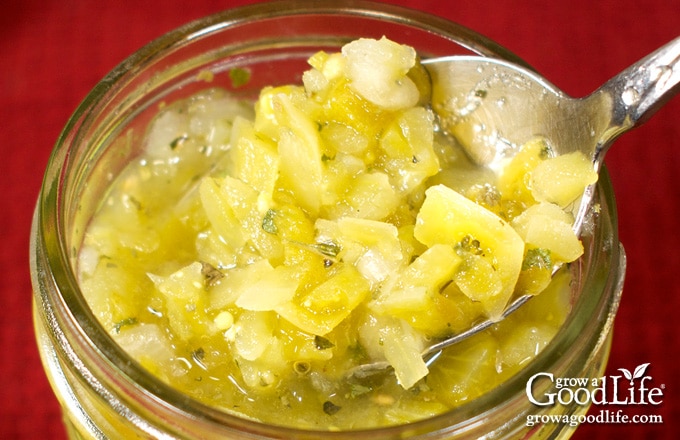
Spicy Green Tomato Salsa Verde Canning Recipe
Ingredients
- 7 cups chopped cored peeled green tomatoes
- 5 to 10 medium jalapeño peppers seeded and finely chopped
- 2 cups finely chopped onions
- 2 cloves garlic finely chopped
- 1/2 cup loosely packed finely chopped fresh cilantro
- 1/2 cup bottled lime juice
- 2 teaspoons ground cumin
- 1 teaspoon dried oregano
- 1 teaspoon canning salt
- 1 teaspoon ground black pepper
Instructions
Prepare the Canning Equipment:
- Wash your jars, lids, screw bands, and canning tools in hot soapy water. Rinse thoroughly to remove any soap residue. Place the washed jars, lids, and screw bands on a clean kitchen towel to air dry.
- Insert the jar rack into the water bath canner and place it on the stove.
- Arrange the jars in the canner, ensuring they are upright and not touching each other. Add enough water to the canner to completely cover the jars.
- Bring the canner to a simmer (180˚F) for 10 minutes, and keep the jars hot until you are ready to fill them.
Make the Salsa:
- Add the prepared tomatoes, onions, peppers, garlic, cilantro, and lime juice to a large saucepot. Stir them together to combine.
- Place the saucepot over medium-high heat and bring the mixture to a boil, stirring constantly to prevent sticking or scorching.
- Once the salsa reaches a boil, add the cilantro, cumin, oregano, salt, and pepper. Stir well to combine the mixture.
- Reduce the heat to medium and let the salsa gently boil for 3 minutes, stirring frequently to prevent any sticking or burning.
- Turn off the heat and get ready to fill your jars with the delicious homemade salsa.
Can the Salsa:
- Prepare your workspace by spreading a kitchen towel on the counter. Using a jar lifter, carefully lift a jar from the canner, allowing the water to drain back into the canner. Place the hot jar on the towel while keeping the remaining jars in the canner to maintain their heat.
- With the help of the canning funnel and a ladle, fill the jar with the hot salsa, leaving a 1/2-inch headspace at the top.
- Use a clean, damp cloth to wipe the rim of the jar, ensuring it is free from any residue. Center a lid on the jar and screw on a band until it is fingertip tight. Place the jar back into the canner using the jar lifter. Repeat this process with the remaining jars, leaving some space between them.
- Once all the jars are in the canner, adjust the water level so that it is at least 2 inches above the tops of the jars.
- Cover the canner and bring the water to a boil over high heat. Once it reaches a vigorous boil, continue boiling pint and half-pint jars for 20 minutes at altitudes of less than 1,000 feet (Adjust the processing time for your altitude if necessary – See notes.).
- After the processing time is complete, turn off the heat and allow the canner to cool down for approximately 5 minutes.
- Place a dry kitchen towel on the counter. Carefully remove the cover of the canner, tilting it away from you to prevent steam burns. Use the jar lifter to lift the jars from the canner and place them on the towel, keeping them upright.
- Do not tighten the bands or check the seals at this point. Instead, allow the jars to cool completely undisturbed for 12 to 24 hours.
- After the cooling period, check to be sure the jar lids have sealed by pushing on the center of the cover. The lid should not pop up. If the top flexes up and down, it did not seal. Refrigerate the jar and use it up within a week.
- Remove the screw-on bands and wash the jars to remove any residue. Label and date the jars, then store them in a cool, dark place for 12 to 18 months.
- Let the salsa develop its flavor for several weeks before opening a jar to let the flavor develop. Once opened, refrigerate the salsa and consume it within a week. This recipe yields 6 half-pints or 3 pints of delicious green tomato salsa verde.
Notes
Nutrition
This green tomato salsa verde canning recipe is a fantastic way to preserve unripe, green tomatoes from your garden. With each jar of homemade salsa, you’ll savor the zesty tang and versatility this condiment brings to your favorite dishes.
Expand your salsa repertoire with these tantalizing options, perfect for preserving the harvest and filling your pantry shelves with diverse flavors to enjoy all year round:
- Roasted Tomatillo Salsa Verde: Experience the smoky and tangy flavors of this classic Mexican salsa. Roasting the tomatillos brings out their natural sweetness, while jalapeños and cilantro add a kick of heat and freshness. It’s the perfect companion to tortilla chips, tacos, or grilled meats.
- Tomato Jalapeño Salsa: If you’re craving a bolder flavor profile, this tomato jalapeño salsa delivers. Bursting with the vibrant colors and flavors of ripe tomatoes, spicy jalapeños, and fresh lime juice, this salsa is both versatile and addictive. Enjoy it with your favorite Mexican dishes, as a topping for burgers, or as a zesty dip.
- Zesty Salsa: Looking to spice things up? Dive into the bold and fiery flavors of this zesty salsa. Packed with a medley of tomatoes, peppers, onions, and aromatic spices, this salsa will awaken your taste buds with its vibrant heat and tanginess. It’s the perfect accompaniment to grilled meats, tacos, or as a flavorful addition to your favorite recipes.
With these canning recipes, you can savor the flavors of your garden harvest and fill your pantry with a diverse array of salsas. So embrace the art of canning and enjoy the taste of summer whenever you please.
If you love salsa, consider adding our eBook, Grow a Good Life Guide to 50 Salsa Canning Recipes, to your resource library. This 72-page eBook is packed with a variety of delicious salsa recipes, including classic tomato salsas to roasted and grilled salsas to tomatillo and delicious fruit blends, all safe for water bath canning. It’s the perfect guide to help you preserve your garden harvests.

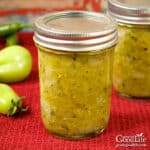

I followed your recipe exactly….it turned out delicious. Thank you for such a long explanation. It is perfect.
Debbie, Thank you, your kind words mean a lot! I am so happy you found the recipe easy to follow and you loved the results.
do you have to peel the tomatoes? I’m using a combo of tomatoes including cherries.
Kay, Yes, this recipe requires peeling the tomatoes. I do have a Pickled Green Tomato recipe that does not require peeling.
Can the tomatoes, garlic, onions and peppers be roasted first?
MaryLynn, Certainly! You can absolutely roast the tomatoes, garlic, onions, and peppers before using them in your green tomato salsa. Roasting these ingredients can add a delicious depth of flavor to your salsa. Just be sure to include any juice that is released during roasting.